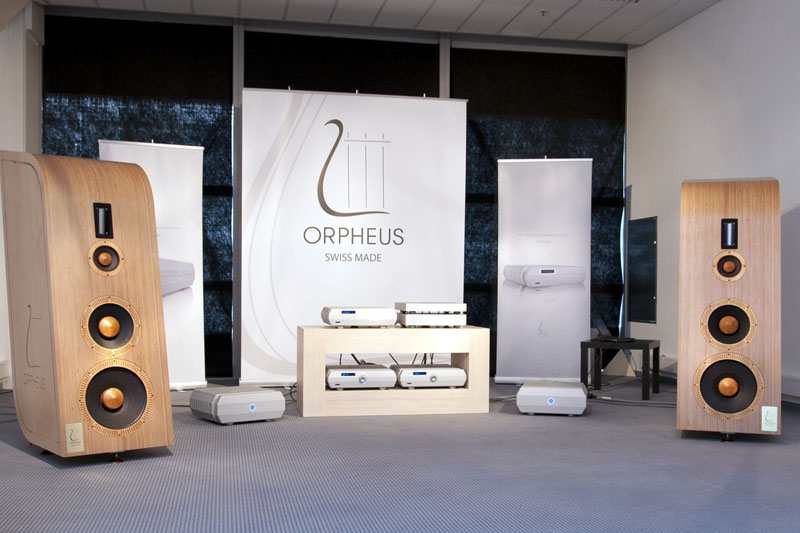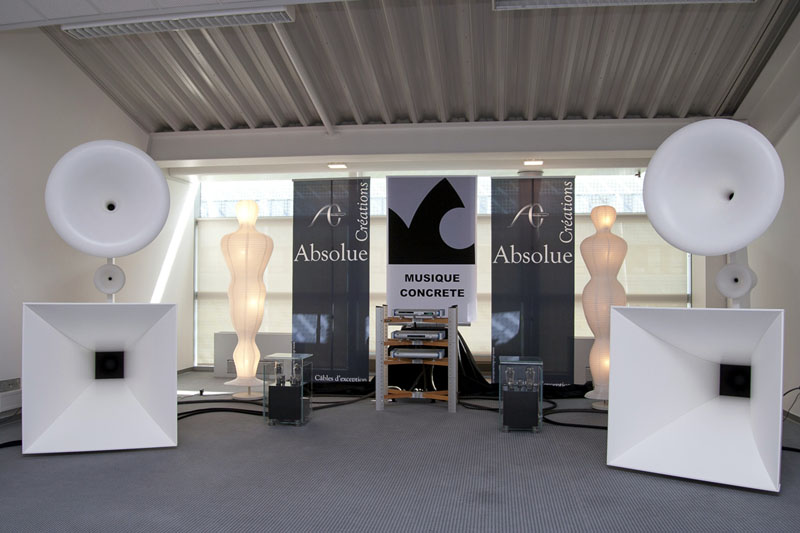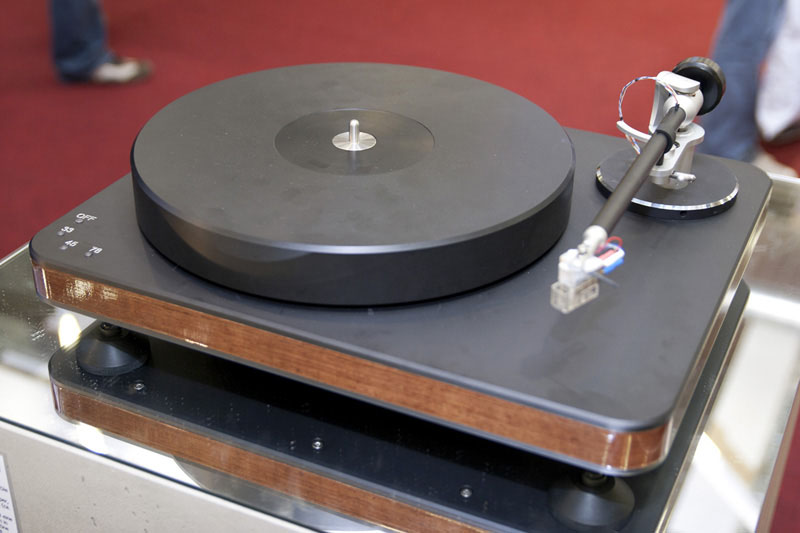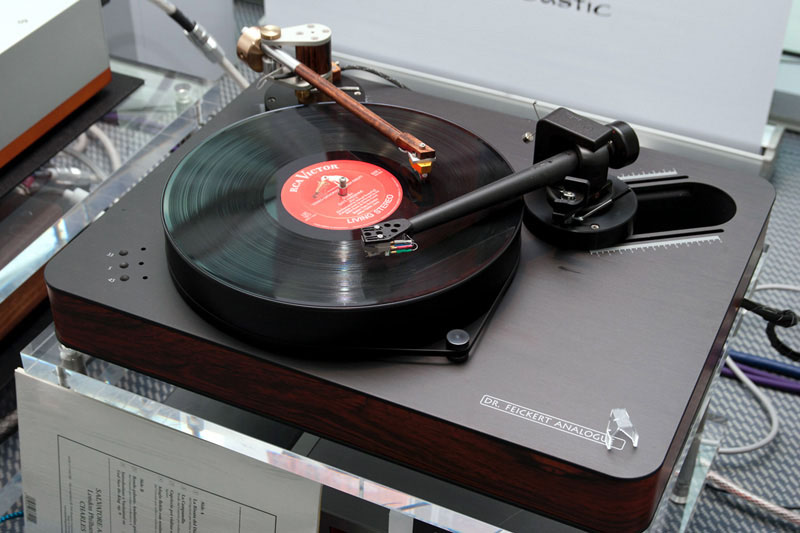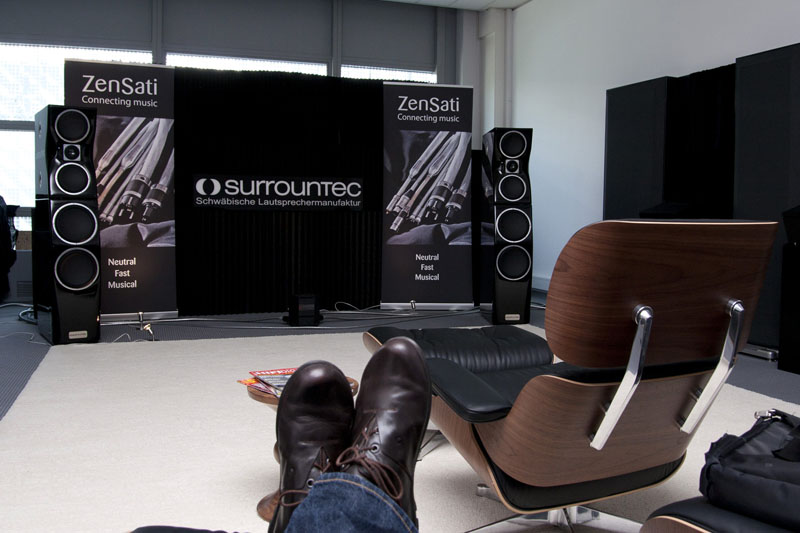High End 2011 • Horns Aplenty
Visiting Munich in southern Germany for the High End show is always great fun. The weather is usually fine and the city itself is beautiful -- and then there’s the beer. Germans keep the best stuff for themselves, believing that it doesn’t travel. I’m not a big fan of lager, but the beer they serve in the Munich biergartens is extremely quaffable. However, the purpose of my visit was also an entertaining and exciting event -- the High End show in its 30th year and showing no signs of age. This event has become the biggest in Europe for serious audio equipment and competes very strongly with the best in the world in terms of overall scope and quality. In fact, I know of no other single-venue event that has as many exhibitors, many of which manage to make very engaging and convincing sound, thanks to Munich's MOC. This dedicated exhibition complex has some pretty decent rooms in the back corridors behind glass-fronted spaces. Throughout the year, these are used for display of everything from jewelry to high fashion. High End is on three levels, with a zoo area on the ground floor that’s largely occupied by companies that aren’t putting on demos, the exceptions being booths built for the purpose that work reasonably well if exhibitors avoid trying to plumb the depths.
The more interesting demos go on in the corridors that flank two first-floor atriums. Here among the meeting rooms are plenty of high-ticket systems that play rather too many audiophile recordings but often do so with considerable success. The first room that caught my ear was that of Orpheus Lab, a Swiss electronics manufacturer with a range of superbly finished digital and analog components. What made this room interesting, however, was the speakers being used. They were among the biggest at the show, weighing in at over 600 pounds, thanks to cabinet construction largely of stacked plywood. Details were thin on the ground, but the Orpheus SP3.0 (€60,000/pair introductory price), as it’s known, appears to be a transmission-line design, if the massive vent on the rear and the cutaway section of a smaller model from the same designer are anything to go by. The designer is a young Swiss fellow, Sven Boenicke, who has used three paper-cone drivers that top out at 15" for the bass unit. Highs are produced by a ribbon from RAAL, and the combination creates a high-sensitivity speaker with serious bandwidth. The drivers come from pro audio and have wooden phase plugs custom made for the job. The wooden edge overlays are there to improve the look of the things. Sensitivity was quoted as 99dB, and the ease and openness of the sound backed this up, the system managing to combine high resolution with awesome dynamics and genuine air-moving capability. For those concerned about the bass becoming overwhelming, Boenicke included a simple output adjustment system for this end of the spectrum. He's not as serious as he looks in the picture (down below) and taller in person, and he had the balls to put on real-world music from the likes of Faithless and deliver a result that had me captivated. The Orpheus room and a few other good-sounding demos had four small black blocks on sticks placed around them. These were marked Stein H2 and appeared to be passive devices but have an on/off switch and control knob on one side. Turns out they are "Harmonizers" of the sort that give high-end audio something of a reputation. Perhaps it was just coincidence that they seemed to be in some of the better-sounding rooms. One room that relied on traditional hardware and software alone was that of Silbatone. This Korean company cemented its reputation for bringing classic Western Electric theatre horns to big shows by doing so for the second time in Munich (they also did the same at CES earlier this year). Silbatone makes seriously expensive valve amplification that has design input from J.C. Morrison and tube-culture steering from Joe Roberts of Sound Practices fame. Joe was in Munich clonking the steel horn of a Western Electric Model 16 speaker from 1928 to demonstrate the state of the theatrical art back in the day. This extraordinary speaker features two compression drivers per side to which Silbatone added compression-driven tweeters on stands and a field-coil-powered subwoofer in a wooden box underneath the horn. Playing an Artemis Labs turntable through the silver-output-transformered valve amplifier and thence to this vintage speaker resulted in a remarkably dynamic, immediate and relatively uncolored result, given the material and technology in use. ZZ Top’s "Blue Jean Blues" has rarely sounded as captivating or as essential. The Model 16 is the oldest speaker in Silbatone’s collection, but its sound would embarrass plenty of newcomers to the game. The rules of physics do not seem to change with time.
The other speaker system in the room was a replica pair of Western Electric 9700A three-way horns from GIP Laboratory of Japan. This company not only supplies the superb cabinet work but has made its own versions of the classic Western Electric drive units using modern techniques and materials. This may be why its speakers sounded considerably smoother, more powerful and better extended than the vintage alternative. A Jonas Hellborg bass workout was positively riveting, the combination of speed and tonal body was not something I’ve heard outside fully active systems, and even they don’t have the ease of a decent horn. It’s inspiring to see a company building these drive units again. Prices are high -- the 9700A comes in at over $200,000 -- but the highest of Japanese high-end audio has never been affordable, and what counts is that someone is doing more than keeping the flame alive by putting field-coil drivers and classic compression drivers into production once again.
The French seem to like a high-sensitivity speaker as well, and a young company with the name Musique Concrète was making some extremely beguiling sounds with its rather elegant La Grande Castine (€98,000/pair) "definitive musical transducer." This white creation stands 6'6" tall and weighs 285 pounds, but what’s remarkable about it is that the midrange and treble horns are made of concrete. You’d never guess as much, because they are totally smooth and extremely thin for such a material. They look more like fiberglass, but don’t have quite such a polished finish. Musique Concrète was an avant-garde musical movement of the late 1940s in France started by Pierre Schaeffer, whose Five Studies of Noises got the ball rolling. Thankfully the company was playing rather more relaxed tunes and had top-notch ancillaries from MSB and The Lars, with its Model 2 amplifiers. The speakers are not only novel in construction. They also have some unusual features inside, not least being beeswax capacitors and non-soldered connections using Absolute Creation cables, which Musique Concrète’s Marc Henry says produced a measurable reduction in distortion. Horns need to be even bigger than this to produce low frequencies, so the company has built a sub-bass system called Infra (€9,000 each). This consists of a 36" cone in an open baffle that’s not a lot bigger. Musique Concrète makes the whole thing itself and claims that it’s the only way to get bass that matches the speed of the horn. If the sound it was making in the room is anything to go by, Henry and crew have succeeded. They were sticking with less-than-demo material, but it sounded exceptionally even and enjoyable. Marc Henry is the founder of the company and the guy who perfected the use of concrete in the speakers' construction. His partners include Hugues Borsarellom, a professional violinist with expertise in electronics -- an unusual combination. This was not the only great-sounding room to feature MSB’s Platinum Signature DAC IV (from $13,995) and its Universal Media Transport ($3995), but it was just the best-sounding one, thanks to the loudspeakers and The Lars tube amps, no doubt. Having reviewed the DAC IV, I can vouch for its superiority and understand why so many companies were using it. There was competition from the British equivalent, dCS, in equally as many rooms, but they didn’t have quite the dynamics and vitality that the MSB-equipped rooms offered.
There were naturally plenty of very fine turntables in Munich, several of which were being given their first public outing. One caught my eye because it signals a change of tack for a well-established brand. The Clearaudio Ovation (€3,900) is the second turntable from the company to use a Delrin platter rather than one fashioned from acrylic. This softer material is considerably more like vinyl than acrylic, and the turntables made with it that I’ve used (from Townshend and Dr. Feickert) have been particularly good. The Ovation contains another innovation in the form of a mat of steel balls -- 100,000 of them, according to Clearaudio's Robert Suchy. They are claimed to soak up resonance and turn it into heat. The Ovation was not actually playing, so its was impossible to assess, but it has me interested, that’s for sure. Clearaudio’s shiny turntables still largely use acrylic platters, but this could well change if the market responds positively to the Ovation.
A Dr. Feickert Blackbird (€5,490) was performing extremely well in the Fast Audio room, where Frank Schröeder had set up one of his beautiful hardwood Reference tonearms alongside the brutal form of a Kuzma Stogi Reference, both running Lyra cartridges through Connoisseur phono amplification. This front-end sounded super sweet through AMR amps and stacked Kiso Acoustics HB-1 speakers ($16,000/pair). Rather than attempting to defeat or tune out resonance, these tiny speakers have cabinets built by Japanese guitar maker Takamine with the aim of producing musically harmonious resonance. This is controversial approach that results in a relatively low-sensitivity speaker, but one that works well in pairs, it would seem.
At the opposite end of the scale, PMC, the British speaker company with strong ties to the pro-audio world, brought a 5.0-channel fully active system with which to demonstrate what can be achieved when real power is connected directly to the drive units. Bryston supplied nine channels of amplification, electronic crossovers and a Torus mains conditioner to power the system and put its new SP 3 preamp/processor in the driver's seat. The result, costing a total of £147,000, was highly convincing. The grip that this PMC BB5 XBD-fronted system delivered was nothing short of bone-crunching, your bones having been softened up by the sweat-inducing temperature that all that amplification helped produce. It was, however, worth it for those of us who like to be able to feel as well as hear the music. I even endured a particularly Germanic Blu-ray of dark classical choral work -- for a while. Devialet’s D-Premier digital amplifier (€11,920) has jumped on the streaming bandwagon in its own distinctive way. Rather than offer a new product, Devialet has produced a receiver that fits into the existing amp and accepts signal from a PC or Mac that has the company’s driver onboard. Described as an embedded asynchronous WiFi streamer, it sounded particularly fine via a pair of Magico Q3 floorstanders fed by a MacBook. The receiver is said to accept signals up to 192kHz and, naturally enough, it does the clocking onboard. The system produced very chewy, textured bass with Serge Gainsbourg’s "Melody Nelson" -- Rickenbacker bass doesn’t get much tastier than that particular French nugget -- and it worked very smoothly with more contemporary jazz from the Avishai Cohen Trio.
Where are the drivers? The Backes & Müller BM100 (left) and GIP Laboratory 9700A. One of the most intriguing products in Munich was on static display only. The Backes & Müller BM100 (as yet unpriced) is a spectacular-looking line-source horn with dramatic polished metal flanks. It stands 7'6" high and has a total of 16 drivers, but none of them is visible. What’s more, the whole thing is actively driven via DSP crossovers, and the company is quoting a sensitivity figure of 120dB. If the Germans had a more obvious sense of humor, I might have taken this for an elaborate hoax, but it looks pretty convincing. I’ll be looking the company up at the next High End show in the hopes of hearing this speaker.
Swiss speakers: the Pawel Acoustics Elektra (left), and designer Sven Boenicke next to the Orpheus Lab SP3.0. The Munich show is always a blast, I took an extra day this year in an attempt at getting some more listening time in, but it’s difficult to sit still when there’s so much to see and hear. As listening shows go, however, High End is up there with the best, and occasionally you get to hear great music too, like a vinyl pressing of Eleni Mardell’s Country for True Lovers. This had uncanny emotional power played on a Holborn Analogue 1 turntable with a Tubesound cartridge, Art Audio tube amps and Pawel Acoustics Elektra speakers (€9950/pair), a fairly obscure and largely Swiss speaker system that gets straight to the heart of the music.
At the end of the day, I needed to put
my feet up at this event, and I found the best place to do this: on the Eames chairs and
foot stools in the Surrountec room. The active speakers here sounded good, but at
around $300,000 per pair, it's easy to understand why the company brought some nice, comfy
chairs. |

